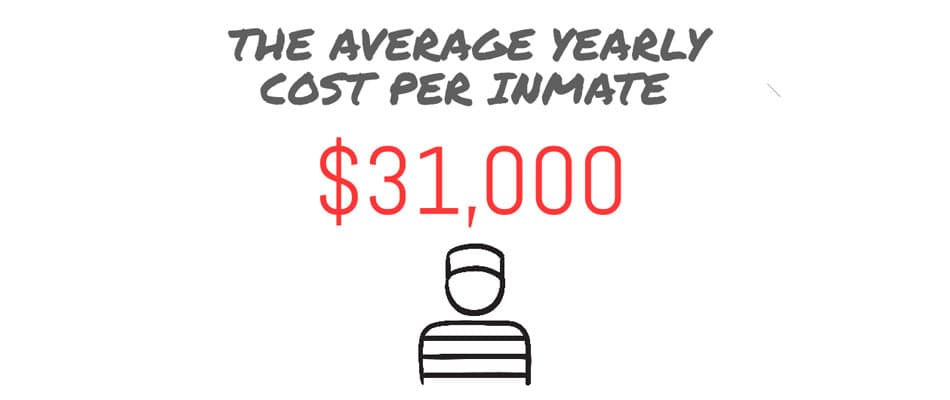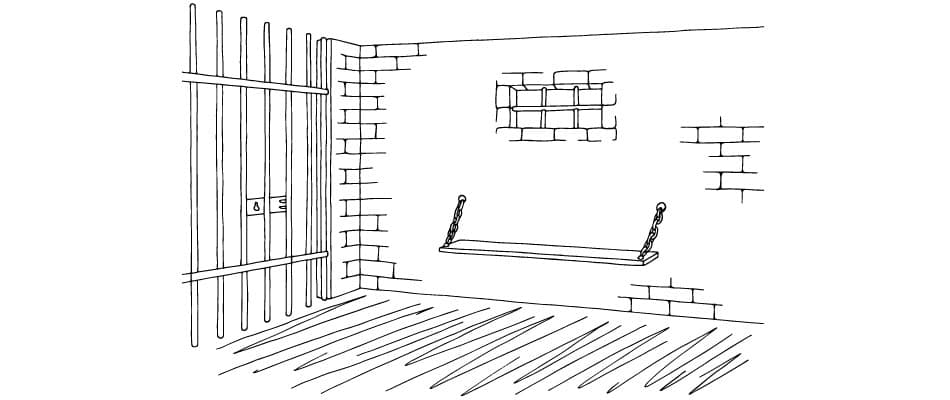Let's Talk !

The average yearly cost per prisoner is $31,000. If we channel resources into improving our information technology system with jail management software, we can greatly reduce this bottom line. Resources are lost to disparate software systems and inefficiencies we can combat with automation.
Although the need for more integrated data management is universal, some industries have shown greater tenacity toward implementation, readily seeking next-generation intelligence to triumph over an evolving dataset. Unfortunately, the prison system is not at the forefront of these campaigns and has never been a known trailblazer in the software development landscape (or any landscape for that matter). That said, what we know about correctional facilities will soon be turned upside down.
Our sources in Corrections tell us the industry is revving up for a total infrastructural overhaul, investing heavily to diagnosis and treat their underlying pain points with integrated software solutions.
The drive for better equipped, better run correctional facilities is actively vocalized, considering the institution holds 2.3 million inmates in 1,719 state prisons, 102 federal prisons, and 3,163 local jails. 1 in every 200 people is living behind a set of bars according to the Washington Post. Mass incarceration is an understatement here. Even more, individuals go to jail, the interim accommodations for the accused between arrest and conviction; 11 million individuals are processed in jails each year.
Yes, the statistics are staggering, but imagine the data flow correctional facilities must process on a month-to-month basis: health records, criminal records, sentencing information, and mental health information. That is just for the offenders, but what about employees and grounds management? Inventory management? Ultimately, correctional facilities operate like any other business, so why is there hesitation to invest in the technologies required to modernize their infrastructure and evolve past their growing deficits?
Below we look a little deeper into three of the avenues our partners in the Corrections industry are taking to banish manual processes that debilitate operations using Jail Management Software, the anticipated ROI, and the way Chetu fits into your infrastructural remodel.
Here’s where we’re going if you want to jump ahead:
1. Why Your Jail Management System Is Failing
There's probably more than one reason, but let's focus on the operations side. An unfathomable number of moving parts are coming together when trying to sustain a prison population with a frenetic ebb and flow of departures and arrivals.
We have inmates that need to be checked in and inmates that need to be checked out. We have cell assessments to adjust, and inventory to scale. After according to the latest reports of Statista.com, the average state prison houses over 650,000 inmates each day in local jails in the United States during 2020. Making sure the basic needs are met for a population of that size is an arduous undertaking, and keeping peace among a group predisposed to crime requires constant intervention.
If we can forge an integrated information management system where all of those needs are met through intuitive data aggregation, where orders are automatically scaled and fulfilled according to the prison population, and inmate profiles are easily generated and archived we can greatly reduce a highly inflated bottom line.

Your current means of jail management is failing because your legacy system does not support interoperability. We must bring all the moving parts under a singular set of software services, opening them up to one another and facilitating cross-channel communication. You need real-time access, where records are accessible immediately so that after an arrest, the inmate's record is shared with the corresponding jail/prison so that the records are now available for any authorized correctional officer.
By eliminating information management silos, correctional facilities gain a holistic, automated view of the prospective facility where all changes are transparent and articulated immediately.
With a more holistic view, we can more easily pinpoint inefficiencies and money pits, pivoting accordingly to reduce that bottom line.
2. The Cloud: Let’s Lock Up Our Data in a Place It Can’t Escape
Let’s be honest—there’s a lot of liability wrapped up in Corrections, and corrections facilities spend a lot of time and money wrapped up in civil litigation. According to a study on inmate litigation, an average of 27 out of every 1000 inmates pursue some sort of legal action against the prison system they were incarcerated within. The primary topics for these lawsuits include medical care issues, disciplinary procedures, religious suppression, and infringement on inmate privileges (visiting, mail, phone, etc.).
No matter the topic of litigation, there is one thing that could discredit any evidence against a corrections facility, complete and total transparency. The best way to accomplish total transparency is by being forthcoming and robust with on-site data collection, which most commonly manifests in the form of video surveillance. Most correctional facilities have these faculties by now, this isn't some cutting-edge concept, however, if the video is low-quality, black and white, and analog, what purpose does it really serve?

The most incapacitating part of the current video surveillance architecture is the way it's being stored. At some point, prisons max out their storage bandwidth trying to log a constant video stream for later access. When they max out their bandwidth, curated data must be deleted to make room for new data. In deleting archives, the facility becomes vulnerable to lawsuits.
If we were to transition all video surveillance and all other data of that matter, to a cloud-based system we eliminate all retrieval errors and solidify archives. The cloud server will also support the new wave of surveillance technologies sweeping the corrections landscape. Some of these technologies include:
Suspicious activity identification and subsequent notification
Heat mapping
Desktop to mobile streaming
Facial recognition
Body cameras for guards
These technologies require intelligent data management capabilities only supported by cloud-based systems. No on-site server can accommodate the storage space modern video streaming demands.
The cloud can be accessed from anywhere with internet connectivity, as the data is stored on a remote server. Storing remotely reduced the opportunity for tampering since the data is completely transparent to every individual with access. Being a gatekeeper for digital evidence comes with a set of responsibilities outlined by the Criminal Justice Information Service and the Federal Information Processing Standards. Mishandling the information through falsified video records is less of a concern when the data is stored on a singular, collaborative platform.
If we increase bandwidth, we can increase the intelligence of our video surveillance systems, reducing the number of lawsuits lost to a lack of digital evidence.
3. Recidivism? What about Correctional Staff Retention?
Although prisons may be overpopulated, there’s a larger problem at play that leaves the entire system open to a slew of vulnerabilities: understaffed facilitates. Correctional facilities are facing difficulties in both the hiring and recruiting process, and for the most part, it’s cyclic--potential hires shy away from opportunities because of the current Corrections climate, and current employees find themselves in an overpopulated/understaffed environment they are eager to leave.
Hiring more individuals would produce a more palatable inmate-to-guard ratio, making correctional recruiting a more desirable commodity and the current employees would be less likely to seek alternative employment.
To streamline the recruitment and retention process, correctional facilities can invest in tracking software that unifies the recruiting and employee reporting modules, forging greater accessibility for all entities (supervisors, officers, new hires, etc.). We’re hitting both pain points here—standardizing recruitment and automating personnel data management to reduce turnover.
There is intensive training required for each new hire, a series of classroom-based learning sessions, combined with defensive and tactical training that closely mirror police cadet onboarding. Here, recruits become highly attune to potential dangers and how to circumvent adversity and violence. Inevitably, prisons are high-risk, the ability to reduce risk through proper training is paramount to a correctional climate for the sake of the employees and the other inmates as well. Employee tracking software can be programmed with the principles, concepts, and procedures inherent to an effective training program, ensuring that all new recruits undergo the same process and are held to the same standards.
We can track how much time has passed since the instruction to implement refresher courses to maintain a level of consistency among the workforce. These alerts can tell us who needs firearms training, which CPR/First Aid certifications have expired, and when the facility is due for a restraint technique class. Continued education is always a sore subject in corrections, but if the units are accessible through employee portals, the onus falls on the individual to fulfill their learning requirements.
Rather than relying on manual scheduling, an Excel-generated report taped to the back of the break room door, Corrections employee tracking software generates individual schedules for all the employees that they can tap into from any device, trading shifts, requesting time off, and making other adjustments directly from their mobile device. Supervisors allocate shifts through an easy-to-use scheduling portal that notifies them when requests are made and distributes their approval to the corresponding team member.
There are a plethora of alerts we can set for different circumstances—emergencies, reaching overtime, shift change, lockdowns, and whatever other actionable items rely on an outdated alert system.
Disclaimer:
Chetu does not affect the opinion of this article. Any mention of a specific software, company or individual does not constitute an endorsement from either party unless otherwise specified. This blog should not be construed as legal advice.
Founded in 2000, Chetu is a global provider of programme applications, solutions and support services. Chetu's specialized technology and industry experts serve startups, SMBs, and Fortune 500 companies with an unparalleled software delivery model suited to the needs of the client. Chetu's one-stop-shop model spans the entire software technology spectrum. Headquartered in Plantation, Florida, Chetu has fourteen locations throughout the U.S. and abroad.
Privacy Policy | Legal Policy | Careers | Sitemap | Referral | Contact Us
Copyright © 2000-2024 Chetu Inc. All Rights Reserved.
